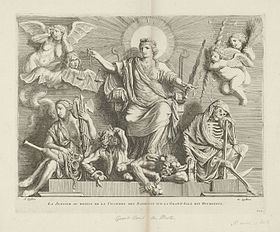Name Hubertus Quellinus Died 1687 | Parents Erasmus Quellinus I | |
 | ||
Hubertus Quellinus or Hubert Quellinus (August 15, 1619, Antwerp – 1687) was a Flemish printmaker, draughtsman and painter and a member of the prominent Quellinus family of artists. His engravings after the work of his brother, the Baroque sculptor Artus Quellinus the Elder, were instrumental in the spread of the Flemish Baroque idiom in Europe in the second half of the 17th century.

Life and work

Hubertus Quellinus was born into a family of sculptors and painters, which included, amongst others, his father Erasmus Quellinus the Elder and his brothers, the Rubens pupil Erasmus Quellinus the Younger and the prominent sculptor Artus Quellinus the Elder. In 1650 he traveled to Rome where he joined the Bentvueghels, an association of mainly Dutch and Flemish artists working in Rome. It was customary for the Bentvueghels to adopt an appealing nickname, the so-called 'bent name'. Hubertus was given the bent name Saracin.
Quellinus was in Amsterdam by 1660 where he collaborated on a publication, which consisted of two parts: the first part consisted of 30 plates depicting the Amsterdam City Hall after designs made by Jacob Vennekool and engraved by Dancker Danckerts while the second part of the publication in two volumes included prints after the marble statues and ornaments executed by Artus Quellinus the Elder in the Amsterdam City Hall. The designs for these prints in the second part were made and engraved by Hubert Quellinus and were marked with the initials of both Artus (A. Q) and Hubertus Quellinus (H. Q). The two parts formed a volume in folio. The first part was published initially in 1655 while the second part was first published in 1663 in Amsterdam but the publisher Frederick de Widt (or 'de Witt') changed the dates on the Quellinus prints to 1665 and 1668. The publication was instrumental in the spread of the Baroque style in Northern Europe until the end of the 17th century, and was used by nearly all followers of the Flemish Baroque style in Europe as the most important pattern-book and source of inspiration in the fields of architectural ornamentation and sculpture.
Quellinus also engraved some portraits and is known for a few history paintings.
